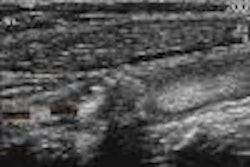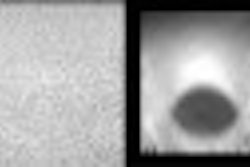ATLANTA - For women being treated with tamoxifen, sonohysterography offers better information about suspected endometrial abnormalities than biopsy, according to a presentation this week at the American Roentgen Ray Society meeting.
Researchers from Memorial-Sloan Kettering Cancer Center in New York City compared endometrial biopsy to sonohysterography in 35 women. The retrospective review was conducted on medical records dating from March 1997 to July 2001. All 35 of the women were on tamoxifen and had undergone endometrial biopsy within six months of sonohysterography.
"Fifty percent of tamoxifen-treated women develop endometrial abnormalities," said Dr. Cathleen Kim in her talk on Tuesday. "The majority of the endometrial abnormalities are benign, including polyps, endometrial hyperplasia, and subendometrial cysts. Polyps occur most frequently and they are a common cause of abnormal bleeding. Tamoxifen polyps have a 3% malignancy rate versus 25% for non-tamoxifen polyps. They are usually surgically resected."
However, there is some debate over how to manage these tamoxifen patients, Kim said. The gynecologoical literature does not recommend routine screening, but "women with abnormal bleeding or endometrial thickening require further evaluation. The optimal method (for evaluation) has not been determined," she added.
At her institution, normal endometrial thickness in asymptomatic tamoxifen-treated women was 8 mm or less. If the patient had vaginal bleeding, the threshold was lowered to 5 mm or less. In the study population, 80% of the women had endometrial thickness greater than 8 mm, Kim explained.
Most of these women (27) were postmenopausal; two were premenopausal; and the menstrual status was unknown for six patients. The mean age was 56. Twenty-one women (60%) reported postmenopausal bleeding, while 74% (26) had thickened endometrium according to prior transvaginal ultrasound exams. Pathology reports for reviewed in 21 cases (60%) in which hysteroscopy with dilation and curettage was done.
Sonohysterographic results for the 35 patients revealed:
- Endometrial polyps in 25 women (71%)
- Subendometrial cysts in 12 women (34%), nine of whom also had coexistent polyps
- Normal endometrium or fibroids in 5 women (14%)
- Thickened endometrium of >5 mm in two women (6%)
The endometrial biopsy showed polyps in seven women (20%) and benign results in 23 patients (66%). In five cases (14%) there was an insufficient sample. Sonohysterographic findings were concordant with biopsy in two of the seven women with polyps, while the remaining five cases were reclassified as normal or fibroids.
In the 25 patients with polyps as revealed on sonohysterography, biopsy found two cases (8%) of endometrial polyps; 19 (76%) were benign.
Pathology reports from hysteroscopy, dilation and curettage were considered the gold standard for this study. Surgery revealed endometrial polyps in 79% of the cases for which biopsy results were either benign or insufficient. 81% of the polyps found by sonohysterography were confirmed by pathology.
"In summary, 15 of 18 women with benign or insufficient endometrial biopsy had endometrial polyps at hysteroscopy. Sixteen of 20 polyps by sonohysterography were confirmed by surgical pathology. We had no cases of endometrial cancer and only one case of endometrial hyperplasia, which occurred within a polyp," Kim said. "For the detection of endometrial polyps, sonohysterography had a 100% sensitivity with an 80% positive predictive value." Kim said the information provided by sonohysterography could be valuable in planning treatment, particularly if surgery is being considered.
By Shalmali PalAuntMinnie.com staff writer
May 2, 2002
Related Reading
Tamoxifen and estrogen have similar effects on the brain, April 18, 2002
Tamoxifen confuses uterine appearance on ultrasound, December 11, 2001
Ultrasonography effectively measures tamoxifen's effect on endometrium, October 12, 2000
Tamoxifen side effect calls for uterine-imaging protocol, January 1, 2000
Copyright © 2002 AuntMinnie.com



















